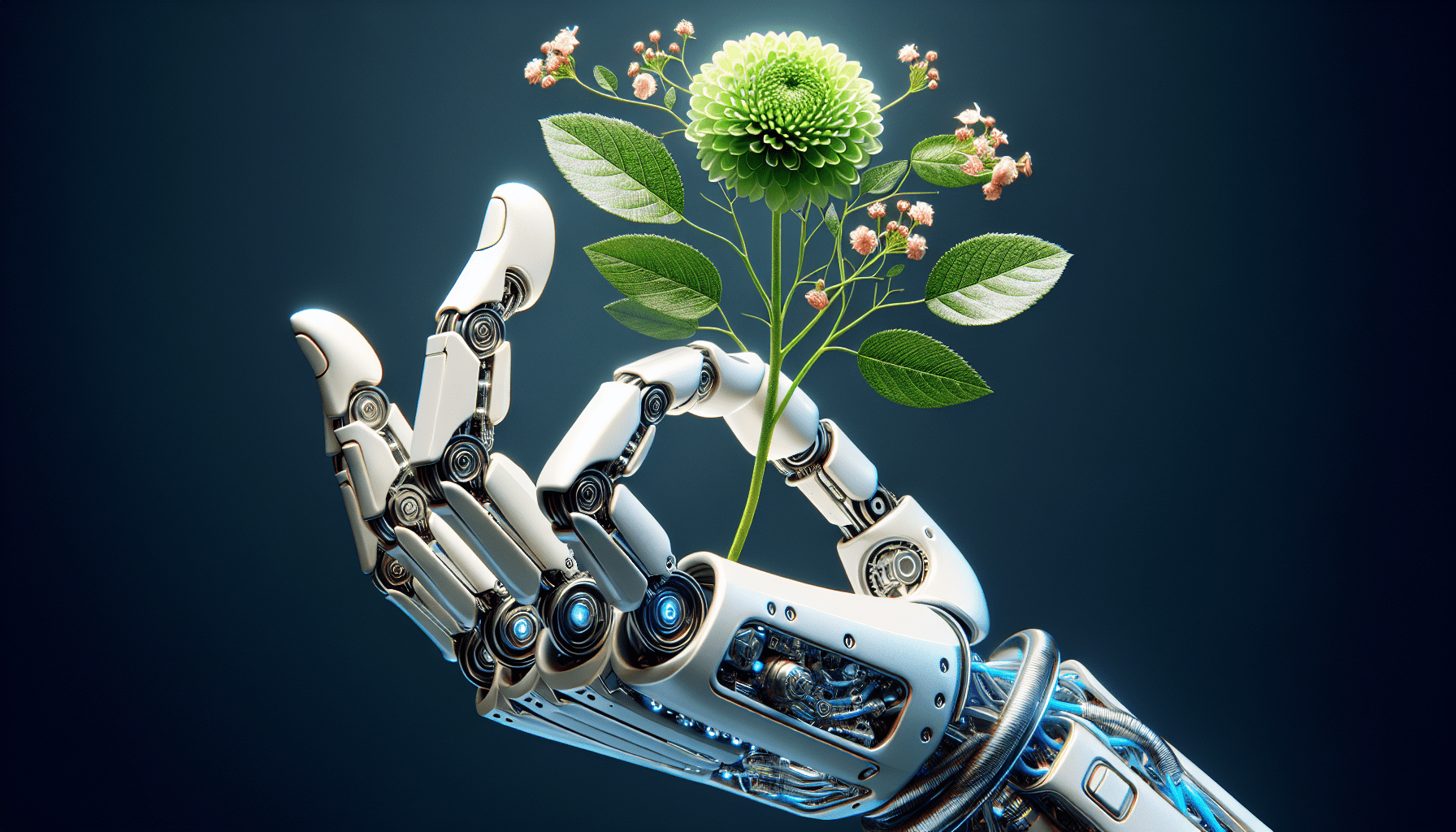Are you curious about the exciting world of Artificial Intelligence (AI) but don’t know where to start? Look no further! “AI Fundamentals for Newbies” is here to guide you through the basics of AI in a friendly and approachable manner. In this article, we will demystify the core concepts and functions of AI, providing you with a solid foundation to understand this rapidly evolving field. Whether you’re a beginner or simply want to brush up on your knowledge, this article is designed to make AI accessible to all. So, join us as we embark on a journey to explore the wonders of AI together!
What is AI?
Artificial Intelligence (AI) refers to the simulation of human intelligence in machines that are programmed to think and learn like humans. It is a branch of computer science that aims to create intelligent machines capable of performing tasks that typically require human intelligence. AI uses algorithms and data to mimic human cognitive functions such as learning, problem-solving, and decision-making.
Definition of AI
AI is a field of study that encompasses various techniques and approaches to create intelligent systems. It involves the development of algorithms and models that enable machines to perceive, reason, and act in ways that imitate human intelligence. AI can be classified into different categories based on the level of intelligence exhibited by the machines, ranging from narrow AI to general AI and superintelligent AI.
AI vs. Human Intelligence
While AI aims to replicate human intelligence, there are fundamental differences between AI and human intelligence. Human intelligence is highly flexible, adaptable, and capable of understanding complex concepts without explicit instructions. On the other hand, AI relies on predefined rules, algorithms, and data to perform tasks. While AI can surpass human capabilities in specific domains, human intelligence remains superior in terms of creativity, emotional intelligence, and abstract thinking.
Examples of AI in Everyday Life
AI has become an integral part of our daily lives, even if we may not always realize it. From virtual assistants like Siri and Alexa to recommendation systems on streaming platforms, AI is present in various applications. AI is used in healthcare for disease diagnosis and treatment recommendations, in finance for fraud detection and risk assessment, and even in autonomous vehicles for navigation and object recognition. AI is transforming industries and revolutionizing the way we live, work, and interact with technology.
Types of AI
AI can be categorized into different types based on their level of intelligence and capabilities.
Narrow AI
Narrow AI, also known as weak AI, refers to AI systems designed to perform specific tasks within a limited domain. These systems are highly specialized and focused on solving narrow problems. Examples of narrow AI include voice recognition systems, image recognition software, and recommendation algorithms. Narrow AI is prevalent in many applications today and represents the majority of AI systems that exist.
General AI
General AI, also known as strong AI or human-level AI, aims to develop machines that possess the ability to understand, reason, and perform any intellectual task that a human being can do. While general AI remains a hypothetical concept, researchers strive to create machines that exhibit human-like intelligence across a wide range of cognitive tasks. Achieving general AI is considered a significant milestone in the field of AI.
Superintelligent AI
Superintelligent AI goes beyond human-level intelligence and refers to AI systems that surpass human capabilities in virtually every aspect. This concept is often associated with the idea of artificial general intelligence (AGI) that surpasses human intelligence in all domains. Superintelligent AI, if achieved, could potentially outperform humans in complex problem-solving, strategic planning, and even scientific research.

Key Concepts in AI
To understand AI better, it’s essential to grasp the key concepts and techniques that underpin its functioning.
Machine Learning
Machine Learning (ML) is a subfield of AI that focuses on the development of algorithms and models that enable computers to learn and make predictions or decisions without being explicitly programmed. ML algorithms can learn from and analyze data to uncover patterns, make predictions, and improve performance through experience.
Deep Learning
Deep Learning is a subset of ML that simulates the functioning of the human brain’s neural networks. Deep learning algorithms are capable of automatically learning from large amounts of unstructured data, such as images or text, to perform tasks with a high degree of accuracy. Deep learning has achieved remarkable success in various domains, including computer vision and natural language processing.
Neural Networks
Neural Networks are computational models inspired by the biological structure and function of the brain. They consist of interconnected nodes (neurons) that process and transmit information. Neural networks are fundamental in deep learning and their ability to learn from data, recognize patterns, and make predictions makes them crucial in many AI applications.
Natural Language Processing
Natural Language Processing (NLP) focuses on enabling computers to understand, interpret, and generate human language. NLP allows machines to analyze and process text, speech, and other forms of natural language to perform tasks such as sentiment analysis, language translation, and speech recognition.
Computer Vision
Computer Vision is an interdisciplinary field that combines AI, ML, and computer science to enable machines to see and interpret visual information. Computer vision algorithms can analyze and understand images and videos, enabling tasks like object recognition, image classification, and facial recognition. Computer vision has extensive applications in surveillance, autonomous vehicles, and medical imaging.
Applications of AI
AI has a vast range of applications across various industries and domains, transforming the way we live and work.
Virtual Assistants
Virtual Assistants, such as Siri, Alexa, and Google Assistant, are AI-powered systems that can understand and respond to voice commands. They can provide information, perform tasks, and even control smart home devices, making our lives more convenient and efficient.
Recommendation Systems
Recommendation Systems use AI algorithms to analyze user preferences and behavior to provide personalized recommendations. These systems are widely used in e-commerce platforms, streaming services, and social media platforms to suggest products, movies, music, and content tailored to individual users.
Autonomous Vehicles
AI plays a crucial role in the development of autonomous vehicles. Machine learning and computer vision algorithms enable vehicles to perceive their environment, interpret road signs, detect objects, and make real-time decisions, leading to the advancement of self-driving cars and safer transportation systems.
Healthcare
AI has the potential to revolutionize healthcare by improving diagnostics, treatment planning, and patient care. AI algorithms can analyze medical images, identify disease patterns, and aid in the diagnosis of illnesses. Additionally, AI-powered chatbots and virtual assistants can provide personalized healthcare information and support.
Finance
In the finance industry, AI is used for fraud detection, risk assessment, and algorithmic trading. AI algorithms can analyze vast amounts of financial data to identify patterns, anomalies, and potential risks. They can also assist in making investment decisions and optimizing portfolios.
Education
AI is increasingly being integrated into education to enhance personalized learning experiences and facilitate efficient education management. Adaptive learning platforms use AI algorithms to tailor lessons and materials to individual students’ needs and learning styles. AI-powered chatbots can also provide instant assistance and support to students.

How AI Works
AI systems follow a series of steps to process information, learn from data, and perform tasks.
Data Collection
AI systems require data to learn and make informed decisions. Data collection involves obtaining relevant and representative datasets that are crucial for training and evaluating AI models. Datasets can consist of structured or unstructured data, such as text, images, or sensor data.
Data Preprocessing
To ensure high-quality and reliable results, data preprocessing involves cleaning, transforming, and organizing the collected data. This step may include removing duplicates, handling missing values, normalizing data, and converting data into suitable formats for analysis.
Training the AI Model
Training an AI model involves feeding the preprocessed data to the model and adjusting its parameters through a process called optimization. Machine learning algorithms learn from the data by identifying patterns, relationships, and rules. The model is trained iteratively, with adjustments made to improve its performance.
Testing and Evaluation
Once the AI model is trained, it needs to be tested and evaluated to assess its performance and ensure its effectiveness. Testing involves feeding the trained model with new, unseen data to evaluate its predictive accuracy, generalization, and robustness. Evaluation metrics, such as accuracy, precision, recall, and F1 score, are used to measure the model’s performance.
Deploying the AI Model
After testing and evaluation, the AI model is ready to be deployed and integrated into real-world applications. Deployment may involve optimizing the model for efficiency, scalability, and security, and integrating it with existing systems or platforms. Continuous monitoring and updating are often necessary to ensure the model’s performance and adaptability over time.
Ethical Considerations in AI
As AI continues to advance, ethical considerations are becoming increasingly important to address potential challenges and risks.
Bias in AI
AI systems can inherit biases present in the training data, leading to discriminatory or unfair outcomes. Addressing bias in AI requires diverse and inclusive data representation, careful selection of training data, and continuous monitoring and evaluation to detect and mitigate bias in AI systems.
Privacy Concerns
AI often relies on access to vast amounts of personal data, raising concerns about privacy and data protection. It is crucial to implement strict security measures, data anonymization techniques, and transparent data usage policies to safeguard individuals’ privacy in AI applications.
Job Displacement
AI automation has the potential to replace certain jobs and disrupt traditional employment structures. To mitigate the impact of job displacement, it is important to invest in reskilling and upskilling programs to prepare individuals for new roles and ensure a smooth transition in the workforce.
Transparency and Accountability
As AI becomes more pervasive, ensuring transparency and accountability in AI decision-making is crucial. AI systems should be explainable, and users should have insight into the factors influencing AI-driven decisions. Transparency enables understanding, trust, and ethical use of AI technologies.

Challenges in AI
Despite its vast potential, AI faces several challenges as it continues to advance and be integrated into various domains.
Data Limitations
AI models heavily rely on high-quality, diverse, and representative datasets. However, collecting and labeling such datasets can be challenging, time-consuming, and resource-intensive. Insufficient or biased data can lead to suboptimal results and limited generalization.
Lack of Trust
Trust is crucial for the adoption and success of AI systems. Lack of trust can arise when AI systems make errors, lack transparency, or exhibit unpredictable behavior. Building trust in AI requires ensuring reliability, explainability, and accountability in AI technologies.
Regulatory and Legal Issues
As AI progresses, legal and regulatory frameworks need to adapt to address the ethical and societal implications. Issues such as data privacy, liability for AI-driven decisions, and intellectual property rights present complex challenges that require careful consideration and regulation.
Ethical Dilemmas
AI raises ethical dilemmas, particularly in decision-making processes with potential social, economic, and even life-altering consequences. Questions of fairness, bias, and accountability arise when AI decisions impact individuals or groups. Effective ethical guidelines and frameworks are necessary to navigate these dilemmas.
Future of AI
The future of AI holds immense potential for advancements and transformative impacts across various aspects of society.
Advancements in AI
AI is expected to continue advancing rapidly, with breakthroughs in areas such as reinforcement learning, natural language understanding, and quantum computing. This progress will lead to more sophisticated AI models capable of performing complex cognitive tasks with increased efficiency and accuracy.
Impact of AI on Society
The impact of AI on society will be far-reaching, influencing industries, economies, and daily life. AI has the potential to revolutionize healthcare, transportation, manufacturing, and many other sectors. It will enable new business models, improve decision-making, and create opportunities for innovation and economic growth.
AI in Business and Industries
AI is already reshaping businesses and industries across the globe. It is being used to optimize operations, automate processes, and create personalized customer experiences. AI-driven insights and predictive analytics are enabling businesses to make data-driven decisions and gain a competitive edge.
AI Research and Development
AI research and development will remain a critical area of focus. Continued investment in AI research, interdisciplinary collaboration, and knowledge sharing will drive innovation and accelerate the development of AI technologies. Collaboration between academia, industry, and government will be essential for further advancements.

Skills and Resources for AI
Acquiring the necessary skills and resources is crucial for those interested in venturing into the field of AI.
Programming Languages for AI
Proficiency in programming languages such as Python, R, and Java is essential for implementing AI algorithms and frameworks. These languages provide robust libraries and tools specifically designed for AI development.
Mathematics and Statistics
A solid foundation in mathematics and statistics is fundamental for grasping the underlying principles of AI. Concepts such as linear algebra, calculus, probability, and statistics are essential for understanding and developing AI models.
Online Courses and Tutorials
Online courses and tutorials provide accessible and structured learning resources for AI. Platforms like Coursera, edX, and Udacity offer a wide range of AI courses, covering various topics and skill levels. These courses provide hands-on exercises and practical examples to reinforce learning.
AI Libraries and Frameworks
Leveraging AI libraries and frameworks can streamline AI development. Popular libraries like TensorFlow, PyTorch, and scikit-learn provide prebuilt functions and models that facilitate the implementation and training of AI algorithms.
AI Research and Communities
Engaging in AI research and communities can foster learning, collaboration, and networking opportunities. Participation in conferences, workshops, and online forums allows individuals to stay updated with the latest advancements, connect with experts, and contribute to the AI community.
Hardware Requirements
AI algorithms often require high computational power to process and analyze large datasets. Access to suitable hardware, such as GPUs (Graphics Processing Units) or TPUs (Tensor Processing Units), can significantly accelerate AI development and training.
Getting Started with AI
Embarking on the AI journey requires careful planning and a systematic approach.
Defining Your AI Goals
Begin by defining your AI goals and understanding the specific problem or domain you want to tackle. Identifying the scope and objectives of your AI project will help you focus your efforts and determine the skills and resources required.
Learning the Basics of AI
Start by gaining a basic understanding of AI concepts, techniques, and tools. Online courses, tutorials, and books provide a structured introduction to AI fundamentals, including machine learning, neural networks, and data analysis.
Exploring AI Projects
Exploring existing AI projects and case studies can provide valuable insights and inspiration. Analyze successful AI applications in various domains, understand their approaches, and learn from their challenges and achievements.
Building a Foundation in AI
Develop a strong foundation in mathematics, programming, and statistics as they form the backbone of AI. Strengthening these skills will enable you to understand and implement AI algorithms effectively.
Practicing and Applying AI Skills
Practice is essential for honing AI skills. Apply your knowledge to real-world datasets and problems, and experiment with different AI algorithms and techniques. Engage in AI projects, participate in Kaggle competitions, or collaborate with others to gain practical experience.
By familiarizing yourself with the concepts, tools, and applications of AI, you can embark on a journey of exploration, learning, and innovation. AI has the power to transform industries, solve complex problems, and improve the quality of life. With the right skills and resources, you can contribute to the advancement of AI and shape its future.







Leave a Reply